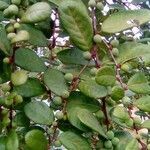Leaf blades 1–12 × 0.5–7 cm, elliptic-obovate to elliptic-oblong, rounded or obtuse, occasionally subacute, cuneate or rounded, rarely ± truncate at the base, margins sometimes revolute, firmly chartaceous to thinly coriaceous, glabrous above, evenly to sparingly pubescent along the midrib and nerves or else subglabrous to quite glabrous beneath, often bluish-green and shiny above, pale grey-green to glaucous and dull beneath; lateral nerves in 7–14 pairs, cheilodromous or brochidodromous, occasionally camptodromous, not prominent or slightly impressed above, slightly to strongly prominent beneath, tertiary nerves scarcely visible to prominent beneath.
A shrub with many stems. It can scramble. It can also be a small tree 4-6 m high. The bark is brown or grey and smooth. The leaves are oblong and 3-9 cm long by 1.5-4.5 cm wide. They are dark green and shiny above and pale green below. The edges are rolled under. The male and female flowers are very small. They are greenish to yellow. They occur in small tight clusters in the axils of leaves. The fruit is 9 mm long by 7 mm wide. They are black when mature. They are edible. There are 2 subspecies and 3 varieties.
Male flowers sweetly-scented; pedicels very short or 0; sepals 2 × 1–1.5 mm, triangular-ovate, acute, glabrous, pale yellowish-green; petals 1×1 mm, flabelliform, erose at apex, pale greenish-or creamy-yellow; disk 1.75 mm in diameter, flat, entire, greenish; staminal column 1.25 mm high, greenish; anthers 0.67 mm long, yellow; pistillode 0.75 mm tall, conic-cylindric, deeply bifid.
Female flowers sessile or subsessile; sepals ± as in the male, but somewhat thicker; petals c. 1 × 1 mm, rhombic-obovate, subentire; outer disk 2 mm in diameter, pentagonal, inner of 3 lobes c. 1 mm high, each lobe ± triangular, toothed; ovary c. 1 × 0.75 mm, ovoid, 2-locular; styles 2, 1 mm long, free, shortly bifid, stigmas uneven, greenish.
Shrub or small tree, up to 6 m high. Leaves without hairs, oblong, elliptic to broadly oblanceolate, 30-90 x 15-45 mm, discolorous, apex broadly tapering to rounded. Flowers green to yellow.
A rather variable scrambling single-or many-stemmed much branched shrub or small tree up to 7 m tall with a dense rounded crown and with horizontal or pendent branches.
Fruit 6–11 × 7–10 mm when dried, subglobose, 2-locular, green at first, later becoming reddish-purple then blackish.
Stipules up to 7 × 1 mm, linear-lanceolate or linear, sparingly pubescent or subglabrous, soon falling.
Young shoots and petioles evenly to sparingly pubescent, puberulous or subglabrous.
Flowers and fruits borne on leafy or wholly or partially leafless shoots.
Bark light grey or brownish, smooth or rough, fissured.
Seeds 7 × 6 × 3 mm, smooth, shiny, chestnut-brown.
Twigs brown, lenticellate.
Petioles 2–5 mm long.


